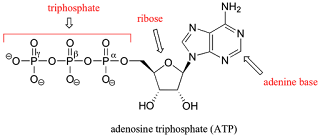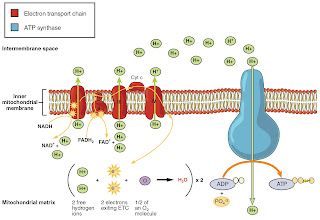
How are free radicals naturally generated in the body?
A plethora of biochemical activities are constantly taking place inside the human body at any given point in time, most of these activities are highly dependent on energy. Basic biology tells us that the main source of energy used by our cells is glucose.
Glucose undergoes a series of metabolic conversions to various products at different stages, culminating in the synthesis of ATP(Adenosine triphosphate).<
ATP is simply an energy currency. Yes, much like the US Dollar, the British Pound and even the perpetually weak Nigerian Naira.
A currency serves two main purposes : A currency is a store of value and a medium of exchange. The figure below illustrates the production of ATP from glucose.

Figure 1. Glucose metabolism ::: Basic medical key
ATP AS AN ENERGY CURRENCY
Let us examine the structure of ATP a bit closely to glean some information about its characteristics.
Figure 2. Structure of ATP Molecule ::: Libretexts
Based on the above structure of ATP, we can tell it contains three (3) phosphate groups (Triphosphate) which are highly unstable owing to the fact that each phosphate group is negatively charged. Basic Chemistry tells us that like-charges exert a repulsive force on each other. This means that these bonds could easily be broken (the scientific term for it is hydrolysed) and the energy stored in those bonds released to power cellular activities.
Alot of enzymes depend on energy to effectively carry out their functions. Specialised proteins (A.K.A pumps) which transport ions such as hydrogen, chloride and calcium ions. Other organic molecules and charged drug molecules are also transported across the cell membrane.
A famous example is the Sodium--Potassium ATPase which uses ATP as an energy source to power the transport of sodium and potassium ions against their respective concentration gradients.
Usually there is a high concentration of sodium ions outside the cell than within, the reverse is true for potassium ions, so the enzyme pumps intracellular sodium out and pumps extracellular potassium into the cell.

Figure 3. Sodium--Potasium ATPase pump ::: Frontalcortex
ANY RELATIONSHIP BETWEEN ATP AND FREE RADICALS?
Electrons released as by-products of glucose metabolism flow down an electron transport chain (ETC) which is essentially a bunch of specialised proteins receiving and passing electrons on to the next protein in the chain.
The ETC generates enough energy to power the chemical synthesis of ATP by an enzyme known as ATP synthase, locaeted just at the end of the ETC. These electrons are ultimately "accepted" by Oxygen which then combines hydrogen ions (also called protons) to form water.

Figure 3. The electron transport chain ::: Courtesy : Wikimedia
But like with most things in life, there is usually a bit of the hiccup now and then, leading to the production of several reactive oxygen species (ROS) or free radicals. Some of these include O-, OH-, H2O2 etc.
Of course these free radicals are not only produced oxidative phosphorylation, other environmental factors also influence their generation in the body. Examples include Ultraviolet radiation, ciggarete smoking, X-rays, air pollutants etc.
SO WHAT'S THE BIG DEAL?
Free radicals are toxic to cells. They react easily with vital cell components (such as DNA, proteins and cell membrane) and cause extensive damages to them.
Free radicals have been implicated in some really nasty diseases like cancer, ischaemic heart disease, gout, atherosclerosis, and a host of neurodegenerative diseases. Yes, they are a nasty bunch!
When produced in small amounts, tney do not pose such a huge problem mainly because our cells come equipped with various mechanisms for dealing with free radicals. Enzymes such as Super OXide Dismutase(SOD), Peroxidase and Catalase, act as scavengers and mop up the excess free radicals.
DO FREE RADICALS SERVE ANY USEFUL PURPOSE?
Research into the workings of the immune system has revealed that neutrophils, the most abundant circulating white immune cell utilises free radicals to destroy foreign invaders. Free radicals are in essence the proverbial double-edged sword.
KEEPING FREE RADICALS ON A LEASH
We have seen that free radicals are incredibly dangerous when allowed to build up to high levels, we also know that a little bit of it is not so bad considering our immune cells use them to keep us a little bit healthier. It is imperative that we maintain a delicata balance.
Earlier we listed a few natural defence mechanisms used by the body to keep free radicals at bay. Let us add a few more names to that list: Vitamin C, Vitamin E, flavonoids, glutathione, etc. [I will write a post on flavonoids in the future].
CONCLUSION
Free radicals are natural by-products of ATP synthesis during oxidative phosphorylation.
Free radicals can cause extensive damages to cell components such as DNA, proteins, cell membranes etc.
Immune cells (neutrophils) use free radicals to kill off foreign invaders.
Free radicals have been implicated in a host of inflammatory diseases.
The body uses specialised enzymes and some vitamins to scavange free radicals and keep their levels relatively low.
Comments
Post a Comment